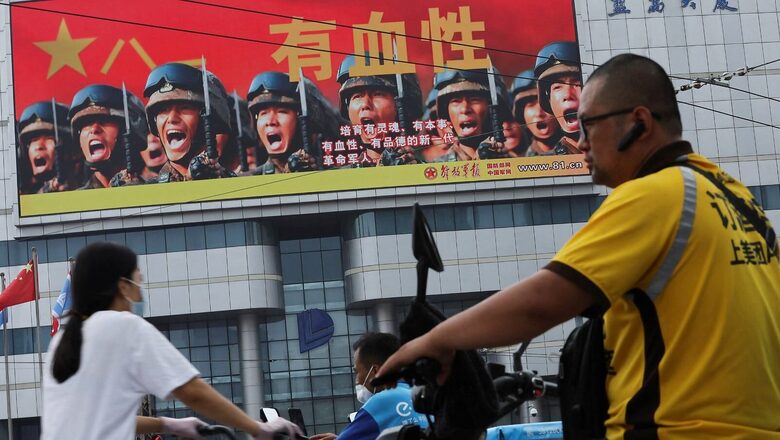
views
The People’s Republic of China (PRC) celebrated the People’s Liberation Army’s (PLA) 95th founding anniversary on 1 August. Formed in 1927 during the Nanchang uprising as an armed wing of the Chinese Communist Party (CCP), the PLA has today become a force to reckon with in the Indo-Pacific region. It is the world’s largest armed force with around 2.03 million active and 510,000 reserve personnel. Its current Chairman, Xi Jinping, who is also China’s President and the CCP’s General Secretary, in 2017, demanded the PLA to be a world-class force by 2049 — a term yet to be defined by him. The best guess is that the Chinese armed forces would be at par with the US, British, French, Russian and even Indian armed forces in some aspects.
It has been over five years since Xi used this term, and recent speeches by the CMC leaders, a few Chinese language publications, China’s doctrinal writings, and analysis by Western scholars help us partially understand what China is trying to achieve with the PLA. Here are three things that the CCP wants the PLA to develop at 95 as it aims to achieve a world-class armed forces status by 2049. First, on 7 November 2020, the CMC released a new “Outline of Joint Operations for the Chinese People’s Liberation Army (Trial).”
Joel Wuthnow and M Taylor Fravel’s analysis confirms that China had already altered its military strategy in 2019 before it released the new military guidelines in November 2020. The new military outlines focus on how the PLA intends to prosecute joint operations in the changing strategic environment — institutionally and operationally. Put simply, it emphasises the PLA’s existing and newer roles, responsibilities and approaches towards its military strategic directions — the primary being “reunification” with Taiwan and one of the secondary directions being its boundary dispute with India.
David M Finkelstein’s work suggests that the outlines could include principles for conducting joint operations, preparation for peace and wartime, the technology needed for it and the mobilisation for conducting it. From this, we understand that the CCP demands the PLA to focus more on what they term “integrated joint operations” (zònghé liánhé xíngdòng), which includes various forces (army, navy, air force, strategic support, etc), theatre commands and smaller units working together across different spaces, terrains and verticals.
Second, China altered its 1993 military strategy a bit in 2014 to call it “winning informatised local wars”. It emphasises the role of informatisation in warfare and justifies the organisational reforms that the CMC has undertaken since Xi’s rise to power. The subsequent defence whitepapers indicate that China assessed the evolution of warfare and concluded that these changes were required to survive in an informatised environment. The 2019 defence white papers claim that “information now plays a leading role in war and is no longer just an important condition.” Previously, the 2015 defence white paper claimed that informatised wars require attaining information dominance within the cyber, space, and electromagnetic domains and rely on the application of advanced information technologies for carrying out all operational and support activities.
Put simply, the PLA’s current changes and operational doctrine build on the aspirations to be a force that conducts integrated joint operations and employs a mix of offensive and defensive concepts to gain information dominance during war and peacetime. The PLA Strategic Support Force (PLA SSF) was possibly formed in 2016 to attain progress in these domains. Thus the CCP demands the PLA to attain information dominance in a comprehensive and focused manner as it moves in the direction of being a world-class force by 2049.
Third, China’s expanding overseas presence and shifting naval strategy are also important considerations for making the PLA a world-class force. Mao Zedong had categorically said that China would not establish a military presence in a foreign land. However, today, China already has a naval outpost at Djibouti in eastern Africa. The PRC is also extremely close to establishing naval outposts on the Solomon Islands and Cambodia. Furthermore, the 2021 US Department of Defence’s Annual Report to Congress on the Military and Security Developments Involving the People’s Republic of China notes that China has considered Myanmar, Thailand, Singapore, Indonesia, Pakistan, Sri Lanka, United Arab Emirates, Kenya, Seychelles, Tanzania, Angola, and Tajikistan, as locations for the PLA facilities for the future.
Besides these three important aspects, the PLA’s evolving training regimes, its personnel policy reforms — which is one of the most undiscussed and ambiguous aspects of the ongoing PLA reforms and its contingency planning (integrating strategic factors such as China’s national interests, PLA missions, and geographically-oriented threat assessments with operational- and campaign-level factors) are important aspects that the CMC and the PLA would work on to achieve the status of a world-class force by 2049.
Read the Latest News and Breaking News here



















Comments
0 comment